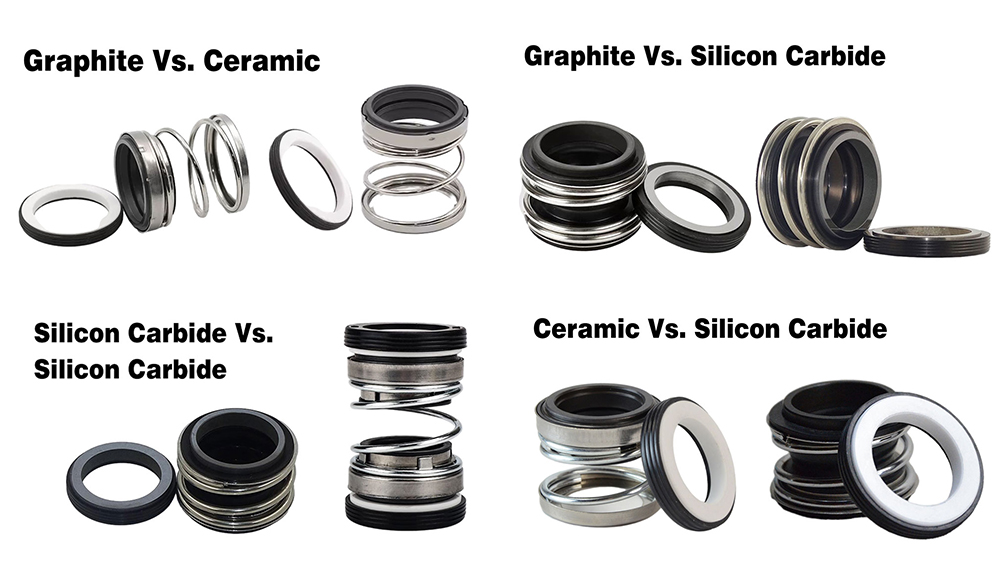+86 13816508465
Apr. 21, 2025

In submersible pumps, mechanical seals are critical for preventing water leakage and ensuring stable operation. At the core of the mechanical seal are two key components: the rotary ring (dynamic ring) and the stationary ring (static ring). The materials used for these sealing surfaces directly impact the pump’s performance, durability, and maintenance cycle.
This article explains the most common materials used in submersible pump seal rings, their advantages and disadvantages, and how to choose the right combination for different working environments.
What Are Rotary and Stationary Rings in a Mechanical Seal?
A mechanical seal in a submersible pump typically consists of a rotating ring (rotary ring) mounted on the shaft and a fixed ring (stationary ring) attached to the pump housing. These two rings are in close contact, forming a tight sealing surface that prevents fluid from leaking out while the pump is running.
Common Seal Ring Materials: Pros and Cons
1. Carbon (Graphite)
Pros:
Excellent self-lubrication
Low friction coefficient
High temperature and corrosion resistance
Good sealing performance
Cons:
Brittle and prone to breakage
Not ideal for fluids containing abrasive particles
Typical Use:
Often used for stationary rings, sometimes also for rotary rings
2. Silicon Carbide (SiC)
Pros:
Extremely hard and wear-resistant
Excellent chemical resistance (acid/alkali)
High thermal conductivity for better heat dissipation
Ideal for high-speed and high-temperature conditions
Cons:
Brittle; can be damaged by mechanical shock
Higher cost
Typical Use:
Used for both rotary and stationary rings in demanding applications
3. Tungsten Carbide (WC)
Pros:
Very high hardness and mechanical strength
Resistant to abrasion and impact
Long service life, even in harsh conditions
Cons:
Heavy and expensive
It may not resist corrosion as well in acidic environments
Typical Use:
Preferred for rotary rings in abrasive or high-pressure applications
Recommended Material Pairings by Application
Choosing the right combination of seal ring materials is essential to match the specific application conditions:
Ring | Rotary Ring | Recommended Use Case | Key Features |
Carbon | Tungsten Carbide | Clean water, light-duty fluids | Cost-effective, general-purpose |
Carbon | Silicon Carbide | Slightly corrosive or sandy water | Enhanced corrosion resistance |
Silicon Carbide | Silicon Carbide | Chemical fluids, high temperature | Premium sealing, industrial use |
Carbon | Hardened Stainless Steel | Household submersible pumps | Budget-friendly, light-duty use |
How to Choose Seal Ring Materials for Submersible Pumps
Here are a few practical tips when selecting seal ring materials:
1. Match the Medium
Clean water or light chemicals: Carbon + Tungsten Carbide
Acidic/alkaline fluids: Silicon Carbide + Silicon Carbide
Sandy or particle-laden water: Tungsten Carbide + Carbon or SiC
2. Consider Working Conditions
High-speed, high-temperature: Favor materials like Silicon Carbide
Intermittent household use: Lower-cost combinations are usually sufficient
3. Balance Performance and Cost
While Silicon Carbide offers excellent performance, it is more expensive and sensitive to installation errors.
Carbon offers great sealing at a lower cost but is best suited for less abrasive environments.
Conclusion
Choosing the right seal ring materials for submersible pumps is key to achieving long-term performance and reliability. Each material has its strengths and weaknesses, and selecting the appropriate combination depends on the fluid type, pump environment, and application frequency.
For reliable submersible pumps with premium seal materials, consider STREAM Submersible Pumps — available in a wide range of models and customizable configurations to meet domestic, agricultural, and industrial needs.
Address
No.17 XeDa Jimei Ind. Park, Xiqing Economic Development Area, Tianjin, China
Telephone
+86 13816508465
QUICK LINKS